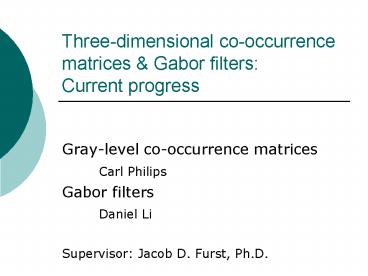Three-dimensional co-occurrence matrices - PowerPoint PPT Presentation
Title:
Three-dimensional co-occurrence matrices
Description:
Linear Discriminate Analysis Decision Tree Gabor filter: Construction Gabor filters: ... – PowerPoint PPT presentation
Number of Views:49
Avg rating:3.0/5.0
Title: Three-dimensional co-occurrence matrices
1
Three-dimensional co-occurrence matrices Gabor
filtersCurrent progress
- Gray-level co-occurrence matrices
- Carl Philips
- Gabor filters
- Daniel Li
- Supervisor Jacob D. Furst, Ph.D.
2
Goals
- Comparison of co-occurrence matrices and Gabor
filters - 2D GLCM vs. 3D GLCM
- 2D Gabor vs. 3D Gabor
- Linear Discriminate Analysis vs. Decision Tree
3
3D image
4
Co-occurrence matrices
- Co-occurrence Matrix
- Distance 2
- Angle 0
1 2 3 4 5 6
1 0 1 1 0 0 0
2 1 0 0 1 0 0
3 1 2 0 0 0 0
4 0 0 1 0 0 1
5 1 1 0 1 0 0
6 1 1 0 1 0 0
- Original Image
1 6 3 4 2
5 6 5 1 5
2 4 4 3 5
4 3 6 2 2
1 3 2 1 1
5
Co-occurrence matrices
- Output 13 Haralick texture descriptors
- Energy
- Entropy
- Correlation
- Contrast
- Inverse Difference Moment
- Variance
- Sum Mean
- Inertia
- Cluster Shade
- Cluster Prominence
- Max Probability
- Inverse Variance
- Mode Probability
6
Co-occurrence matrices
- Global
- Features extracted are for the entire cube
- 13 Directions
- Four original 2D directions
- Nine new 3D directions
- 4 Distances
- 1, 2, 4, and 8 pixels
- 13 features extracted per distance per direction
- 13413676 features per cube
7
Principle Component Analysis
- 676 is far to many features
- Computers unable to perform LDA
- Retain 1.0000 variability with 5 component
- Main variable within each component is Cluster
Tendency
8
Linear Discriminate Analysis
9
Decision Tree
10
Linear Discriminate Analysis results
- Classification of cubes using 2D Co-Occurrence
Matrices and Linear Discriminate Analysis
- 57.6 of the training set correctly classified
- 58.2 of the testing set correctly classified
11
Linear Discriminate Analysis results
- Classification of cubes using 3D Co-Occurrence
Matrices and Linear Discriminate Analysis
- 57.9 of the training set correctly classified
- 51.2 of the testing set correctly classified
12
Decision Tree results
- Classification of cubes using 2D Co-Occurrence
Matrices and Decision Tree
- 93.4 of the training set correctly classified
- 88.8 of the testing set correctly classified
13
Decision Tree results
- Classification of cubes using 3D Co-Occurrence
Matrices and Decision Tree
- 91.7 of the training set correctly classified
- 89.1 of the testing set correctly classified
14
Gabor filters, introduction
Sinusoid
Gaussian
Gabor
15
Gabor filters, a 2D example
16
Gabor filters, a 2D example
17
Gabor filters, a 2D example
18
Gabor filter Construction
Sinusoid1In2D Sinusoid2In2D
Gabor1In2D Gabor2In2D
Gaussian2 Gaussian3
Sinusoid1In3D Sinusoid2In3D Sinusoid3In3D
Gabor1In3D Gabor2In3D Gabor3In3D
19
Gabor filters The five filters
2D 1-dir and 2-dir
3D 1-dir, 2-dir, 3-dir
20
Gabor filters Our tests
x 3710
Liver cube
x 3710
Non-liver cube
21
Results for Gabor filters
22
Results for Gabor filters
23
Hypotheses for results
- 2D data sets were 20x / 60x larger than 3D data
sets - Scans were not isotropic, and distance in
Z-direction not uniform across patients
24
Future work
- Reduce cases of 2D to be same as 3D and compare
results - Complete 3in3D testing
- Use isotropic data if possible
25
Questions
- Any questions?
26
Co-occurrence matrices
- Output 13 Haralick texture descriptors
- Inertia
- Contrast
- Energy
- Sum Mean
- Entropy
- Correlation
- Variance
27
Co-occurrence matrices
- Output 13 Haralick texture descriptors
- Max Probability
- Inverse Variance
- Mode Probability
- Homogeneity
- Cluster Shade
- Cluster Prominence































